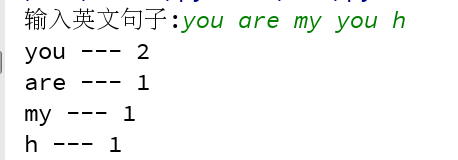python資料型別之字典
阿新 • • 發佈:2019-02-11
字典:key :value 鍵值對儲存的一種資料結構
value值可以是任意資料型別:int float long list tuple set dict
1. 字典的建立
d = {}
print(d,type(d))
輸出結果:
{} <class 'dict'>
d = {
'張三':[18,'男','玩手機'],
'李四':[18,'女','修手機']
}
print(d)
print(d['李四'])
輸出結果:
{'張三': [18, '男', '玩手機'], '李四': [18, '女', '修手機']}
[18, '女', '修手機']
d2 = { 'a':1, 'b':2 } print(d2) d3 = { 'a':{1,2,3}, 'b':{2,3,4} } print(d3) 輸出結果: {'a': 1, 'b': 2} {'a': {1, 2, 3}, 'b': {2, 3, 4}}
- 字典的巢狀
students = {
'06163012':{
'name':'豬豬女孩',
'age':18,
'score':90
},
'03162003':{
'name':'狗狗男孩',
'age':19,
'score':80
}
}
print(students['03162003']['name'])
輸出結果:
狗狗男孩
- 工廠函式
d5 = dict(a=1,b=2)
print(d5)
輸出結果:
{'a': 1, 'b': 2}
2. 字典的特性
- 字典的所有操作都是通過它的key
d = {
'1':'a',
'8':'b',
'2':'a'
}
print(d['1'])
#print(d['a']) #會報錯
輸出結果:
a
-
字典不支援索引
print(d[0])這個寫法會報錯,因為0不是這個字典的key,字典只能通過key查詢value -
字典不支援切片
print(d[::-1])報錯 -
字典的重複和連線是無意義的,因為字典的key是唯一的
-
成員操作符:判斷的也是 某個值是否為字典的key
d = { '1':'a', '8':'b', '2':'a' } print('1' in d) print('1' not in d) 輸出結果: True False
- 字典的for 迴圈: 預設遍歷字典的key值
for key in d:
print(key)
輸出結果:
1
8
2
for key in d:
print(key,d[key])
輸出結果:
1 a
8 b
2 a
2. 字典的增加
1.增加一個元素
1).如果key值存在,則更新對應的value值
2).如果key值不存在,則新增對應的key-value值
services = {
'http': 80,
'ftp': 21,
'ssh': 22
}
services['mysql'] = 3306
print(services)
services['http'] = 443
print(services)
結果:
{'http': 80, 'ftp': 21, 'ssh': 22, 'mysql': 3306}
{'http': 443, 'ftp': 21, 'ssh': 22, 'mysql': 3306}
2.新增多個key-value值
1).如果key值存在,則更新對應的value值
2).如果key值不存在,則新增對應的key-value值
services = {
'http': 80,
'ftp': 21,
'ssh': 22
}
service_backup = {
'tomcat':8080,
'https':443,
'http':8888
}
services.update(service_backup)
print(services)
services.update(flask=9000,http=999)
print(services)
結果:
{'http': 8888, 'ftp': 21, 'ssh': 22, 'tomcat': 8080, 'https': 443}
{'http': 999, 'ftp': 21, 'ssh': 22, 'tomcat': 8080, 'https': 443, 'flask': 9000}
3.setdefault新增key值:
1).如果key值存在,則不做修改
2).如果key值不存在,則新增對應的key-value值
services = {
'http': 80,
'ftp': 21,
'ssh': 22
}
services.setdefault('http',9000)
print(services)
services.setdefault('oracle',44575)
print(services)
結果:
{'http': 80, 'ftp': 21, 'ssh': 22}
{'http': 80, 'ftp': 21, 'ssh': 22, 'oracle': 44575}
3. 字典的刪除
1. del關鍵字
services = {
'http': 80,
'ftp': 21,
'ssh': 22,
'mysql':3306
}
del services['http']
print(services)
輸出結果:
{'ftp': 21, 'ssh': 22, 'mysql': 3306}
2.pop刪除指定的key的key-value值
1.)如果key存在,刪除,並且返回刪除key對應的value值
2.)如果key不存在,直接報錯
services = {
'http': 80,
'ftp': 21,
'ssh': 22,
'mysql':3306
}
item = services.pop('http')
print(item)
print(services)
輸出結果:
80
{'ftp': 21, 'ssh': 22, 'mysql': 3306}
3.popitem刪除最後一個key-value
services = {
'http': 80,
'ftp': 21,
'ssh': 22,
'mysql':3306
}
item = services.popitem()
print('刪除的key-value對應的是:',item)
print(services)
輸出結果:
刪除的key-value對應的是: ('mysql', 3306)
{'http': 80, 'ftp': 21, 'ssh': 22}
4.清空字典內容
services = {
'http': 80,
'ftp': 21,
'ssh': 22,
'mysql':3306
}
services.clear()
print(services)
輸出結果:
{}
4. 字典的修改與查詢
- 檢視字典裡面的key值
service = {
'http':80,
'mysql':3306
}
print(service.keys())
輸出結果:
dict_keys(['http', 'mysql'])
- 檢視字典裡面的value值
service = {
'http':80,
'mysql':3306
}
print(service.values())
輸出結果:
dict_values([80, 3306])
- 遍歷字典
service = {
'http':80,
'mysql':3306
}
for k,v in service.items():
print(k,'---->',v)
for k in service:
print(k,'---->',service[k])
輸出結果:
http ----> 80
mysql ----> 3306
http ----> 80
mysql ----> 3306
- 檢視指定key對應的value值
key值不存在,程式會報錯
service = {
'http':80,
'mysql':3306
}
print(service['http'])
#print(service['https']) 會報錯
輸出結果:
80
-
get 方法獲取指定key對應的value值
如果key值存在,返回對應的value值
如果key值不存在,預設返回None,如果需要指定返回的值,傳值即可
service = {
'http':80,
'mysql':3306
}
print(service.get('http'))
print(service.get('https','不存在'))
輸出結果:
80
不存在
5. 字典的小練習
- 練習一
-
生成100個卡號;
卡號以6102009開頭, 後面3位依次是 (001, 002, 003, 100), -
生成關於銀行卡號的字典, 預設每個卡號的初始密碼為"redhat";
-
輸出卡號和密碼資訊, 格式如下:
卡號 密碼
6102009001 000000
"""
fromkeys第一個引數可以是 list/tuple/str/set
將第一個引數的元素作為字典的key值
並且所有key的value值一致,都為'00000000'
"""
# print({}.fromkeys({'1','2'},'0000000'))
#儲存所有卡號列表,也可以通過集合來儲存
card_ids = []
# 生成100個卡號
for i in range(100):
# %.3d代表這個整型數佔3位 eg:1--->001
s = '6102009%.3d' %(i+1)
# 將每次生成的卡號都加入到列表中
card_ids.append(s)
card_ids_dict = {}.fromkeys(card_ids,'redhat')
# print(card_ids_dict)
print('卡號\t\t\t\t\t密碼')
for key in card_ids_dict:
print('%s\t\t\t%s' %(key,card_ids_dict[key]))

-
練習一
重複的單詞: 此處認為單詞之間以空格為分隔符, 並且不包含,和 . ;- 使用者輸入一句英文句子;
- 打印出每個單詞及其重複的次數;
str=input('輸入英文句子:')
word_list=str.split(' ')
word_dict={}
for i in word_list:
times=1
if i in word_dict:
times+=1
word_dict[i]=times
for k,v in word_dict.items():
print(k,'---',v)

- 練習二
數字重複統計:
1). 隨機生成1000個整數;
2). 數字的範圍[20, 100],
3). 升序輸出所有不同的數字及其每個數字重複的次數;
